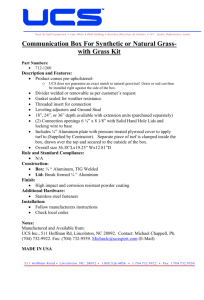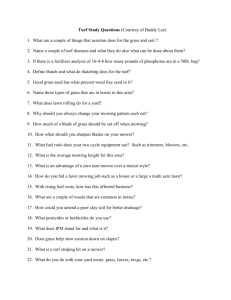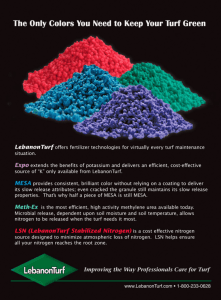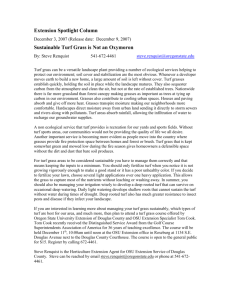Oregon State University Fertilizer Guide tor &M,A
advertisement
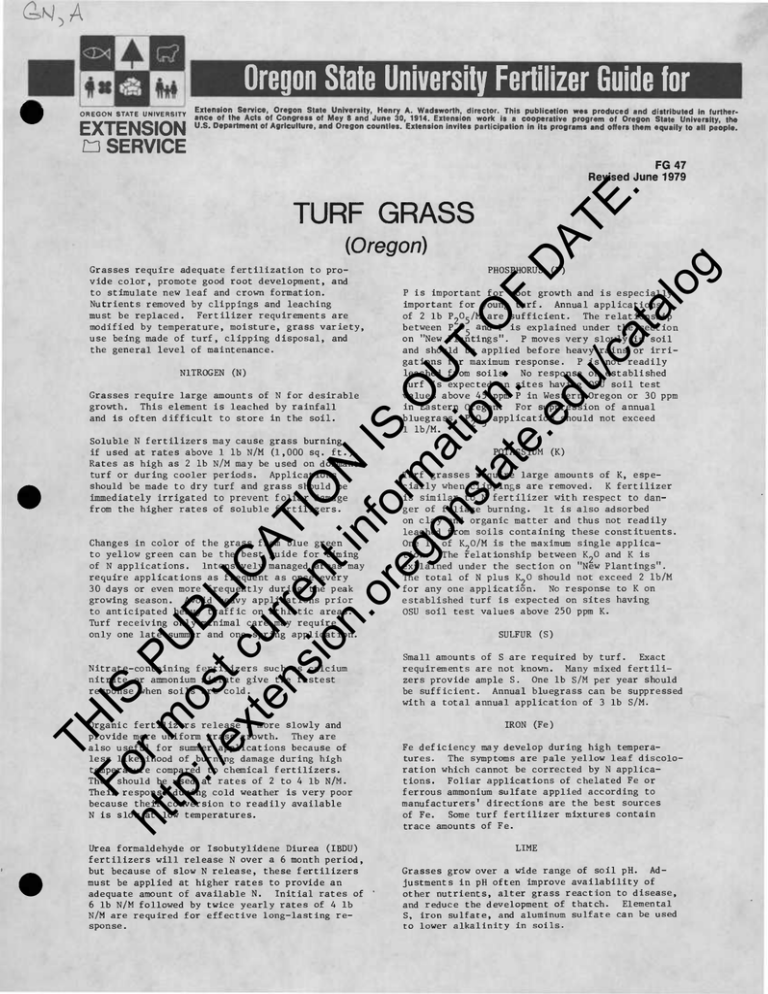
&M,A Oregon State University Fertilizer Guide tor _"" ' - .■^' " ' ' H X I ENSION Extension Service, Oregon State University, Henry A. Wadsworth, director. This publication was produced and distributed In further•nee of the Acts of Congress of May 8 and June 30, 1914. Extension work is a cooperative program of Oregon State University, the U S ' ' Depar,men ' °' A9ricullure, and Oregon counties. Extension invites participation in its programs and offers them equally to all people. n SERVICE Fo IS ht r m P U tp :// os BL ex t c IC te ur A ns re TI io nt ON n. in or fo IS eg rm O on at U st ion T O at : F e. D ed A u/ TE ca . ta lo g FG47 Revised June 1979 TURF GRASS (Oregon) Grasses require adequate fertilization to provide color, promote good root development, and to stimulate new leaf and crown formation. Nutrients removed by clippings and leaching must be replaced. Fertilizer requirements are modified by temperature, moisture, grass variety, use being made of turf, clipping disposal, and the general level of maintenance. NITROGEN (N) Grasses require large amounts of N for desirable growth. This element is leached by rainfall and is often difficult to store in the soil. Soluble N fertilizers may cause grass burning if used at rates above 1 lb N/M (1,000 sq. ft.). Rates as high as 2 lb N/M may be used on dormant turf or during cooler periods. Applications should be made to dry turf and grass should be immediately irrigated to prevent foliar damage from the higher rates of soluble fertilizers. Changes in color of the grass from blue green to yellow green can be the best guide for timing of N applications. Intensively managed areas may require applications as frequent as once every 30 days or even more frequently during the peak growing season. Avoid heavy applications prior to anticipated heavy traffic on athletic areas. Turf receiving only minimal care may require only one late summer and one spring application. TH Nitrate-containing fertilizers such as calcium nitrate or ammonium nitrate give the fastest response when soils are cold. Organic fertilizers release N more slowly and provide more uniform grass growth. They are also useful for summer applications because of less likelihood of burning damage during high temperature compared to chemical fertilizers. They should be used at rates of 2 to 4 lb N/M. Their response during cold weather is very poor because their conversion to readily available N is slow at low temperatures. Urea formaldehyde or Isobutylidene Diurea (IBDU) fertilizers will release N over a 6 month period, but because of slow N release, these fertilizers must be applied at higher rates to provide an adequate amount of available N. Initial rates of 6 lb N/M followed by twice yearly rates of 4 lb N/M are required for effective long-lasting response. PHOSPHORUS (P) P is important for root growth and is especially important for young turf. Annual applications of 2 lb PjOc/M are sufficient. The relationship between P,0 and P is explained under the section on "New Plantings". P moves very slowly in soil and should be applied before heavy rains or irrigations for maximum response. P is not readily leached from soils. No response on established turf is expected on sites having OSU soil test values above 45 ppm P In Western Oregon or 30 ppm in Eastern Oregon. For suppression of annual bluegrass, P^O, application should not exceed 3 1 Ib/M. POTASSIUM (K) Turf grasses require large amounts of K, especially when clippings are removed. K fertilizer is similar to N fertilizer with respect to danger of foliage burning. It is also adsorbed on clay and organic matter and thus not readily leached from soils containing these constituents. One lb of K.O/M is the maximum single application. The relationship between K„0 and K is explained under the section on "New Plantings". The total of N plus K.0 should not exceed 2 Ib/M for any one application. No response to K on established turf is expected on sites having OSU soil test values above 250 ppm K. SULFUR (S) Small amounts of S are required by turf. Exact requirements are not known. Many mixed fertilizers provide ample S. One lb S/M per year should be sufficient. Annual bluegrass can be suppressed with a total annual application of 3 lb S/M. IRON (Fe) Fe deficiency may develop during high temperatures. The symptoms are pale yellow leaf discoloration which cannot be corrected by N applications. Foliar applications of chelated Fe or ferrous ammonium sulfate applied according to manufacturers' directions are the best sources of Fe. Some turf fertilizer mixtures contain trace amounts of Fe. LIME Grasses grow over a wide range of soil pH. Adjustments in pH often Improve availability of other nutrients, alter grass reaction to disease, and reduce the development of thatch. Elemental S, iron sulfate, and aluminum sulfate can be used to lower alkalinity in soils. Liming of soils with pH lower than 5.8 may be desirable. For bluegrass turf, lime should be applied to soils with pH below 6.3. If OSU soil test reads: The desirable range of calcium:magnesium ratio by OSU soil test is from 2:1 to 12:1. Dolomitic limestone should be applied when there is more than 12 times as much calcium than magnesium. In all other cases, ground limestone should be used to increase the soil pH. pH Apply this amount Ib/M (1,000 sq. ft.) S 10 5 none 5.8 to 6.3 5.3 to 5.8 below 5.3 Lime 100 150 200 200 to 300 150 to 200 below 150 K20 Fo IS ht r m P U tp o :// s BL ex t c IC te ur A ns re TI io nt ON n. in or fo IS eg rm O on at U st ion T O at : F e. D ed A u/ TE ca . ta lo g above 7.8 7.2 to 7.8 6.3 to 7.2 Lime is most effective when incorporated into the soil prior to seeding. The rate of application of lime will depend on the type of soil and the extent to which the pH is to be increased. K (ppm) P (ppm): For Western Oregon MIXED FERTILIZERS Many types and grades of fertilizers are available for turf grass purposes. Requirements of the grass are often most nearly met by formulations supplying annual N-P„0.-K.O ratios of 5-1-2, 4-1-2, 3-1-2 or multiples thereof. APPLICATION TECHNIQUES Uniform application is absolutely necessary to avoid, foliar or tissue burn from the high rates suggested. Hand spreading is usually unsatisfactory. Small spreaders should be adjusted so that two or three coverages are required to spread the material over the area. By going in different directions with each coverage, skips and overlaps will not be apparent. below P (ppm): When using higher rates of soluble nitrogen and potassium, foliar burn can be alleviated by immediate watering of the turf. Soluble materials can be applied through the irrigation system to minimize burning. The fertilizer response will follow the pattern of water dispersal. NEW PLANTINGS TH Obtain an OSU soil test through the County Extension Office. Incorporate the following materials to a depth of 2 to 6 inches during seedbed preparation prior to seeding. 45 P 0 2 5 . For Eastern Oregon below 30 P2O5 Note: The P content of fertilizer is expressed as the oxide (f^0^ on fertilizer labels. Multiply P.0,. by 0.44 to convert to P. Note: The K content of fertilizer is expressed as the oxide (K.O) on fertilizer labels. Multiply K.O by 0.83 to convert to K. Not required for blue grass. 2 Always make sure the spreader is moving when any fertilizer is falling from it. Rotary spreaders are best adapted to odd shaped turf areas but may throw material onto adjacent walks and flower beds. Apply fertilizer only when turf is dry. 1 2 3 For blue grass only. 1 to 2 lb N/M should be incorporated with the above materials. Additional broadcast applications of N at 1 Ib/M should be made as shown by poor grass color. Where S is not applied in the above treatments, 1 lb S/M should be applied. CONVERSION TO METRIC UNITS In this FG, rates of fertilizer application are expressed in pounds per 1000 square feet (Ib/M). In order to convert Ib^M to kilograms per 100 square meters (kg/100 m ), multiply Ib/M by 0.5. Thus 2 Ib/M = 1 kg/100 m . The P, K, Mg, B, and lime recommendations are based on soil test values from the Soil Testing Laboratory, OSU, Corvallis, Oregon. Prepared by Norman Goetze, Wilbur Bluhm, and Hugh Gardner, Cooperative Extension Service, Oregon State University, Corvallis, Oregon. Reviewed by a committee of Oregon County Extension Agents.
